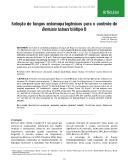| dc.description.abstract | Se evaluó la actividad patogénica de cepas de Beauveria bassiana (25), Metarhizium anisopliae (7), Paecilomyces spp. (11) y Verticillium lecanii (1) en el control de Bemisia tabaci biotipo B. Los experimentos fueron realizados en condiciones controladas (25 más menos 0,5 °C, 80 más menos 5 porciento HR y 12:12 L:D). Se utilizaron hojas de soya infestadas con ninfas de tercer instar, inoculadas con 2 mL de la suspensión (10 exponente 7 conidios/mL), aplicada por medio de una torre de Potter (15 lb pol 2). Todas las cepas fueron patogénicas para las ninfas, causando entre 10 y 89 porciento de mortalidad. Sin embargo, las cepas 447 y 969 (B. bassiana), 1037, 816 y E9 (M. anisopliae), y CB144 (Paecilomyces spp.) alcanzaron 57, 59, 61, 89 y 48 porciento de mortalidad, respectivamente. Fue posible concluir que los aislamientos E9, 1037 y 816 de M. anisopliae y las cepas 447 y 969 de B. bassiana constituyen opciones promisorias para el control microbiano de ninfas de mosca blanca biotipo B. Isolates of Beauveria bassiana (25), Metarhizium anisopliae (7), Paecilomyces spp. (11), and Verticillium lecanii (1) were evaluated for their pathogenicity against third instar nymphs of Bemisia tabaci biotype B. The experiment was conducted under controlled conditions (25 more less 0,5 °C, 80 more less 5 percent RH and 12:12 L:D). Soybean leaves were treated with 2 mL of conidial suspentions (10 exponent 7 conidia/mL), applied thrugh a Potter Tower (15 lb/pol 2). All the isolates were pathogenic to nymphs and caused from 10 to 89 percent of mortality. The most pathogenic isolates were B. bassiana 447 and 969, M. anisopliae 1037, 816 and E9, and Paecilomyces spp. CB144, causing 57, 59, 61, 68, 89 and 48 percent of mortality, respectively. Results indicate that M. anisopliae isolates E9, 1037 and 816, and B. bassiana isolates 447 and 969 are the most promising for the development of bioinsecticides to control silverleaf whitefly nymphs. | es_ES |


